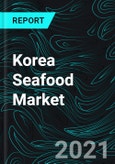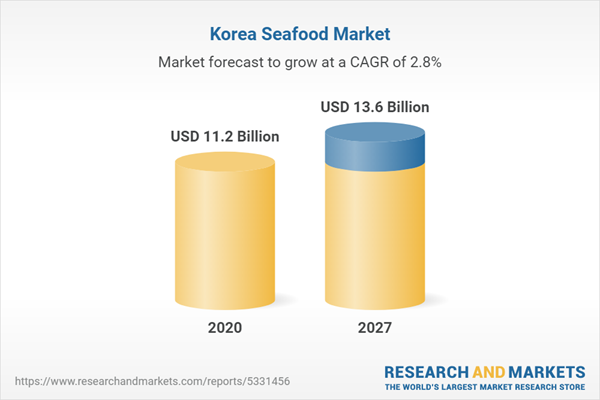In South Korea export of fishery products hit all time high in the year 2018, the most probable export countries was China and Japanese market. According to USDA, with respect to the seafood sector, the United States seafood exporters have more opportunities to export to South Korea as custom duties for fishery products have cut to zero or phased out for 3 to 10 years. As expected, South Korean consumers will take advantage of lower price resulting from cutting down of import duties for fishery products like Squid, Mackerels, Sailfin sandfish etc. According to the publisher Seafood Market of South Korea will grow at a CAGR of 2.81% during 2020-2027.
Over the time, in the Korean market, Norwegian seafood exports have surged due to skyrocketing demand on farmed salmon and mackerel earlier that was dominated by US exporters until 2015. In South Korea, sea food production is done in various types of aquaculture like adjacent water, shallow sea culture, distant waters, and inland water. Shallow water marine environment preferred aquaculture points as water area is between the shore and deeper water which is best-suited habitats for Korean seafood. The Seafood Industry in South Korea was valued at US$ 11.2 Billion in 2020.
In recent years, a decrease in aquaculture and production in South Korea has led to the formation of various policies to increase aquaculture production. The government has prepared a long-term aquaculture development program by increasing cultivation areas for both profitable and unexploited species. South Korea population is increasingly being concern that affects fishing and aquaculture production due to the construction of industrial buildings in the country's southern and western coastal districts. Besides, South Korean people have high disposable income and enjoy seeking products that offers convenience due to their busy lifestyles. The growth factor to this market is the demand for pre-cooked, surging readymade, preserved food demand, and rising double-income families.
COVID-19 impact on Seafood Industry
According to World Health Organization (WHO) and the World Organisation for Animal Health (OIE), food itself is not responsible for the transmission of disease to people.
Production & Supply
- Impacted in distribution channels/supply chain/seafood value chain disruptions
- Low overall seafood production
- Seafood demand and supply imbalance
- Lower restaurant traffic, increase retail sales (supermarkets and e-commerce deliveries)
- Low demand for luxurious seafood products
Consumers
- Demand for seafood remained strong
- Choice of the seafood formats - frozen, fresh, canned - shift in consumer preference/ready to eat, ready to cook meals
- Suspension/Disruption of exports/imports
- Strong domestic markets
- The seafood supply chain is disturbed, and Transport restrictions affect supply chain
- Consumers spending on direct channels for seafood dropped due to movement restrictions
This latest report “South Korea Seafood Market & Volume by Water (Adjacent Water, Shallow Sea Aquaculture, Distant Waters), Products (Fishes, Shellfish, Crustacean), Species (Mackerels, Jack Mackerels, Red Snow Crabs, Snow Crabs, Purplish Washington Clams, Pen Shells, Horned Turban, Blue Crabs, Squids, Sailfin Sandfish, Mottled Skate, Others), Company (Seatrade, Atlantic Capes Fisheries, Inc, Atalanta Corporation, Ideal Foods Ltd, Sea Delights)" provides detailed analysis of Korea Sea Food Industry.
Waters - Market & Volume breakup from 4 viewpoints
- Adjacent Waters
- Shallow Sea Aquaculture
- Distant Waters
- Inland Waters
Product - Volume breakup from 3 viewpoints
- Fishes
- Shellfish
- Crustacean
Species - Volume breakup from 12 viewpoints
- Mackerels
- Jack mackerels
- Red snow crabs
- Snow crabs
- Purplish Washington clams
- Pen shells
- Horned turban
- Blue crabs
- Squids
- Sailfin sandfish
- Mottled Skate
- Others
All companies have been covered from 2 Viewpoints
- Overviews
- Recent Developments
Company Analysis
- Seatrade
- Atlantic Capes Fisheries, Inc
- Atalanta Corporation
- Ideal Foods Ltd
- Sea Delights
Table of Contents
Companies Mentioned
- Seatrade
- Atlantic Capes Fisheries, Inc
- Atalanta Corporation
- Ideal Foods Ltd
- Sea Delights
Methodology
In this report, for analyzing the future trends for the studied market during the forecast period, the publisher has incorporated rigorous statistical and econometric methods, further scrutinized by secondary, primary sources and by in-house experts, supported through their extensive data intelligence repository. The market is studied holistically from both demand and supply-side perspectives. This is carried out to analyze both end-user and producer behavior patterns, in the review period, which affects price, demand and consumption trends. As the study demands to analyze the long-term nature of the market, the identification of factors influencing the market is based on the fundamentality of the study market.
Through secondary and primary researches, which largely include interviews with industry participants, reliable statistics, and regional intelligence, are identified and are transformed to quantitative data through data extraction, and further applied for inferential purposes. The publisher's in-house industry experts play an instrumental role in designing analytic tools and models, tailored to the requirements of a particular industry segment. These analytical tools and models sanitize the data & statistics and enhance the accuracy of their recommendations and advice.
Primary Research
The primary purpose of this phase is to extract qualitative information regarding the market from the key industry leaders. The primary research efforts include reaching out to participants through mail, tele-conversations, referrals, professional networks, and face-to-face interactions. The publisher also established professional corporate relations with various companies that allow us greater flexibility for reaching out to industry participants and commentators for interviews and discussions, fulfilling the following functions:
- Validates and improves the data quality and strengthens research proceeds
- Further develop the analyst team’s market understanding and expertise
- Supplies authentic information about market size, share, growth, and forecast
The researcher's primary research interview and discussion panels are typically composed of the most experienced industry members. These participants include, however, are not limited to:
- Chief executives and VPs of leading corporations specific to the industry
- Product and sales managers or country heads; channel partners and top level distributors; banking, investment, and valuation experts
- Key opinion leaders (KOLs)
Secondary Research
The publisher refers to a broad array of industry sources for their secondary research, which typically includes, however, is not limited to:
- Company SEC filings, annual reports, company websites, broker & financial reports, and investor presentations for competitive scenario and shape of the industry
- Patent and regulatory databases for understanding of technical & legal developments
- Scientific and technical writings for product information and related preemptions
- Regional government and statistical databases for macro analysis
- Authentic new articles, webcasts, and other related releases for market evaluation
- Internal and external proprietary databases, key market indicators, and relevant press releases for market estimates and forecasts

LOADING...
Table Information
| Report Attribute | Details |
|---|---|
| Published | May 2021 |
| Forecast Period | 2020 - 2027 |
| Estimated Market Value ( USD | $ 11.2 Billion |
| Forecasted Market Value ( USD | $ 13.6 Billion |
| Compound Annual Growth Rate | 2.8% |
| Regions Covered | South Korea |
| No. of Companies Mentioned | 5 |









